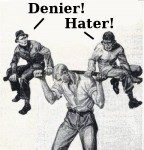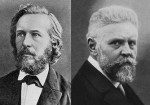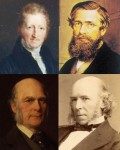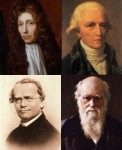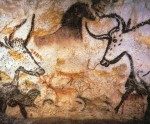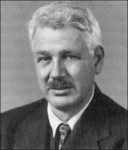A review of the roots of anthropology, the science of humanity, in the early 20th century.
The two main branches of anthropology – physical/biological/racial anthropology and cultural/social anthropology or ethnology – represent an outgrowth of two more general complementary poles of academic thought. As the Wikipedia page for Franz Boas describes, the:
distinction between science and history has its origins in 19th century German academe, which distinguished between Naturwissenschaften (the sciences) and Geisteswissenschaften (the humanities)
Generally, [[the sciences]] refer to the study of phenomena that are governed by objective natural laws, while [[the humanities]] refer to those phenomena that have meaning only in terms of human perception or experience
This dichotomy in anthropology was then and remains today a divide between objective and subjective points of view. Right from the start anthropology became a battleground, with White/Aryan/Nordic racialists gravitating to the one side, and jewish anti-“racists” advocating the other.
Metapedia’s article on physical/biological/racial anthropology notes the jewish origins of the term “racism”:
The term racists was first coined in print by Leon Trotsky, a communist Jew and mass murderer, in a 1930 piece called the History of the Russian Revolution (translated into English in 1932).[2] He coined the term in a paragraph where he is mocking what he called “Slavophilism”, which Trotsky claims is the “messianism of backwardness”.[3] In the same breath, the paragraph on the so-called racists also speaks of “Teutonic jackasses”,[3] thus from the very beginning the term came from the mouth of a communist Jew in a thoroughly Europhobic context. He continues on in a 1933 piece about German socialism, speaking of racism.[4] The -ism itself was popularised largely due to Magnus Hirschfeld, a co-racialist of Trotsky and Sexual Bolshevist agitator in Berlin, in the 1934 work Racism.[5]
The champion of the Nordic side was Madison Grant:
Madison Grant (November 19, 1865 – May 30, 1937) was an American lawyer, known primarily for his work as a eugenicist and conservationist. As a eugenicist, Grant was responsible for one of the most famous works of racial anthropology, and played an active role in crafting strong immigration restriction and anti-miscegenation polices in the United States. As a conservationist, Grant was credited with the saving of many different species of animals, founding many different environmental and philanthropic organizations, and developing much of the discipline of wildlife management.
Grant was born in New York City, New York, to Gabriel Grant, a well-known physician and American Civil War surgeon, and Caroline Manice. Grant was a lifelong resident of New York City. As a child he attended private schools and traveled Europe and the Middle East with his father. He attended Yale University, graduating early and with honors in 1887. He received a law degree from Columbia Law School, and practiced law after graduation; however, his interests were primarily those of a naturalist. He never married and he had no children.
Grant was a close friend of U.S. presidents Theodore Roosevelt and Herbert Hoover. Among other things he founded the Save-the-Redwoods League, helped found the Bronx Zoo, build the Bronx River Parkway, save the American bison, and create Glacier National Park and Denali National Park.
Grant is most famously the author of the popular book The Passing of the Great Race in 1916, an elaborate work of racial hygiene detailing the “racial history” of Europe. The book had eight printings within twenty years and is considered one of the most influential and vociferous works of scientific racism and eugenics to come out of the United States. Coming out of Grant’s concerns with the changing “stock” of American immigration of the early 20th century (characterized by increased numbers of immigrants from Southern and Eastern Europe, as opposed to Western and Northern Europe), Passing of the Great Race was a “racial” interpretation of contemporary anthropology and history, revolving around the idea of “race” as the basic motor of civilization. He specifically promoted the idea of the “Nordic race” — a loosely-defined biological-cultural grouping rooted in Scandinavia — as the key social group responsible for human development; thus the subtitle of the book was The racial basis of European history.
Grant and his opinions on race were, in their own time, popular and celebrated. The sneer quotes in the text immediately above reflect the poisonous contemporary anti-“racist”/jewish influence over it’s original source, Wikipedia.
I think the most effective antidote to this poison is to read Grant’s own thoughts:
The Nordics are, all over the world, a race of soldiers, sailors, adventurers, and explorers, but above all, of rulers, organizers, and aristocrats in sharp contrast to the essentially peasant character of the Alpines. Chivalry and knighthood, and their still surviving but greatly impaired counterparts, are peculiarly Nordic traits, and feudalism, class distinctions, and race pride among Europeans are traceable for the most part to the north.
As Metapedia notes:
One of his long-time opponents was the Jewish anthropologist Franz Boas. Boas and Grant were involved in a bitter struggle for control over the discipline of anthropology in the United States while they both served (along with others) on the National Research Council Committee on Anthropology after the First World War. Grant represented the “hereditarian” branch of physical anthropology at the time, and was staunchly opposed to and by Boas himself (and the latter’s students), who advocated cultural anthropology. Boas and his students eventually wrested control of the American Anthropological Association from Grant and his supporters and used as a flagship organization for his brand of anthropology. In response Grant founded the Galton Society with American eugenicist and biologist Charles B. Davenport in 1918 as an alternative to Boas.
Excerpts from The Passing of the Great Race, Or, The Racial Basis of European History:
PREFACE
European history has been written in terms of nationality and of language, but never before in terms of race; yet race has played a far larger part than either language or nationality in moulding the destinies of men; race implies heredity and heredity implies all the moral, social and intellectual characteristics and traits which are the springs of politics and government.
Quite independently and unconsciously the author, never before a historian, has turned this historical sketch into the current of a great bio- logical movement, which may be traced back to the teachings of Galton and Weismann, beginning in the last third of the nineteenth century. This movement has compelled us to recognize the superior force and stability of heredity, as being more enduring and potent than environment. This movement is also a reaction from the teachings of Hippolyte Taine among historians and of Herbert Spencer among biologists, because it proves that environment and in the case of man education have an immediate, apparent and temporary influence, while heredity has a deep, subtle and permanent influence on the actions of men.
PREFACE TO SECOND EDITION xiii
War is in the highest sense dysgenic rather than eugenic. It is destructive of the best strains, spiritually, morally and physically. For the world’s future the destruction of wealth is a small matter compared with the destruction of the best human strains, for wealth can be renewed while these strains of the real human aristocracy once lost are lost forever. In the new world that we are working and fighting for, the world of liberty, of justice and of humanity, we shall save democracy only when democracy discovers its own aristocracy as in the days when our Republic was founded.
Henry Fairfield Osborn.
December, 1917.
It will be necessary for the reader to divest his mind of all preconceptions as to race, since modern anthropology, when applied to history, involves an entire change of definition. We must, first of all, realize that race pure and simple, the physical and psychical structure of man, is something entirely distinct from either nationality or language. Furthermore, race lies at the base of all the manifestation of modern society, just as it has done throughout the unrecorded eons of the past and the laws of nature operate with the same relentless and unchanging force in human affairs as in the phenomena of inanimate nature.
The antiquity of existing European populations, viewed in the light thrown upon their origins by the discoveries of the last few decades, enables us to carry back history and prehistory into periods so remote that the classic world is but of yesterday. The living peoples of Europe consist of layer upon layer of diverse racial elements in varying proportions and historians and anthropologists, while studying these populations, have been concerned chiefly with the recent strata and have neglected the more ancient and submerged types.
Aboriginal populations from time immemorial have been again and again swamped under floods of newcomers and have disappeared for a time from historic view. In the course of centuries, however, these primitive elements have slowly reasserted their physical type and have gradually bred out their conquerors, so that the racial history of Europe has been in the past, and is to-day, a story of the repression and resurgence of ancient races.
The author also wishes to acknowledge his obligation to Prof. William Z. Ripley’s “The Races of Europe,” which contains a large array of anthropological measurements, maps and type portraits, providing valuable data for the present distribution of the three primary races of Europe.
The image above is purported to be of Grant at Yale in 1887. The source is Classify Madison Grant, where some commenters mock Grant for not looking Nordic enough.
The podcast will be broadcast and available for download on Tuesday at 9PM ET.
Podcast: Play in new window | Download












